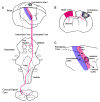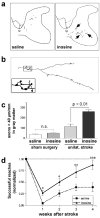Promoting axonal rewiring to improve outcome after stroke
- PMID: 19931616
- PMCID: PMC2818530
- DOI: 10.1016/j.nbd.2009.11.009
Promoting axonal rewiring to improve outcome after stroke
Abstract
A limited amount of functional recovery commonly occurs in the weeks and months after stroke, and a number of studies show that such recovery is associated with changes in the brain's functional organization. Measures that augment this reorganization in a safe and effective way may therefore help improve outcome in stroke patients. Here we review some of the evidence for functional and anatomical reorganization under normal physiological conditions, along with strategies that augment these processes and improve outcome after brain injury in animal models. These strategies include counteracting inhibitors of axon growth associated with myelin, activating neurons' intrinsic growth state, enhancing physiological activity, and having behavioral therapy. These approaches represent a marked departure from the recent focus on neuroprotection and may provide a more effective way to improve outcome after stroke.
Figures


References
-
- Atwal JK, et al. PirB is a functional receptor for myelin inhibitors of axonal regeneration. Science. 2008;322:967–70. - PubMed
-
- Benowitz LI, et al. Axon outgrowth is regulated by an intracellular purine-sensitive mechanism in retinal ganglion cells. J Biol Chem. 1998;273:29626–34. - PubMed
-
- Benowitz LI, et al. The pattern of GAP-43 immunostaining changes in the rat hippocampal formation during reactive synaptogenesis. Brain Research Molecular Brain Research. 1990;8:17–23. - PubMed
-
- Benowitz LI, Routtenberg A. GAP-43: an intrinsic determinant of neuronal development and plasticity. Trends in Neurosciences. 1997;20:84–91. - PubMed
Publication types
MeSH terms
Substances
Grants and funding
LinkOut - more resources
Full Text Sources
Medical

